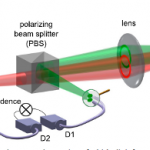lasers
In which we do a little ResearchBlogging, taking a look at a slightly confusing paper putting a new twist on the double-slit experiment.
------------
I'm off to California this afternoon, spending the rest of the week at DAMOP in Pasadena (not presenting this year, just hanging out to see the coolest new stuff in Atomic, Molecular, and Optical Physics). I don't want to leave the blog with just a cute-kid video for the whole week, though, so here's some had-core physics: a new paper in the Proceedings of the National Academy of Sciences (freely available online), looking at a new sort of…
The second in the DAMOP research categories I talked about is "Extreme Lasers," a name I was somewhat hesitant to use, as every time I see "Extreme [noun]," I get a flash of Stephen Colbert doing air guitar. It is, however, the appropriate term, because these laser systems push the limits of what's possible both in terms of the pulse duration (attosecond pulses are common, with 1as = 0.000000000000000001 s) and the pulse intensity (1014 W/cm2 is a typical order-of-magnitude, and some systems get much higher than that).
One of the main tricks for generating these ultra-short pulses is to do…
It's the last week of the (calendar) year, which means it's a good time to recap the previous twelve months worth of scientific news. Typically, publications like Physics World will publish a list of top ten physics stories of 2010, but we're all Web 2.0 these days, so it seems more appropriate to put this to a poll:
What is the top physics story of 2010?survey software
I've used the Physics World list as a starting point, because you have to start somewhere. I added a few options to cover the possibility that they left something out, and, of course, you know where the comments are.
This…
Earlier this week, I talked about the technical requirements for taking a picture of an interference pattern from two independent lasers, and mentioned in passing that a 1967 experiment by Pfleegor and Mandel had already shown the interference effect. Their experiment was clever enough to deserve the ResearchBlogging Q&A treatment, though, so here we go:
OK, so why is this really old experiment worth talking about? What did they do? They demonstrated interference between two completely independent lasers, showing that when they overlapped the beams, the overlap region contained a pattern…
Over at Confused at a Higher Level, Melissa offers an alphabetical list of essential supplies for a condensed matter experimentalist at a small college. This is a fun idea for back-to-school time, so I'll steal it, and offer the following alphabetical list of essentials for Atomic, Molecular, and Optical physics at a small college, kind of a condensed version of the three part series I did a few weeks ago.
A is for Acousto-optic modulator This is a device that uses sound waves in a crystal to deflect light and shift its frequency. It's essential for rapid control of laser properties.
B is for…
The National Science Board made a deeply regrettable decision to omit questions on evolution and the Big Bang from the Science and Engineering Indicators report for 2010. As you might expect, this has stirred up some controversy.
I wasn't surprised to learn this, as I had already noticed the omission a couple of months ago, when I updated the slides for my talk on public communication of science-- the figure showing survey data in the current talk doesn't include those questions, while the original version has them in there. I noticed it, and thought it was a little odd, but it had no effect…
